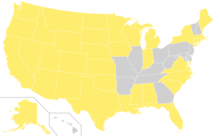This is a list of federally recognized tribes in the contiguous United States. There are also federally recognized Alaska Native tribes. As of January 8, 2024[update], 574 Indian tribes were legally recognized by the Bureau of Indian Affairs (BIA) of the United States.[1][2] Of these, 228 are located in Alaska and 109 are located in California. 346 of the 574 federally recognized tribes are located in the contiguous United States.[3]


Federally recognized tribes are those Native American tribes recognized by the United States Bureau of Indian Affairs as holding a government-to-government relationship with the US federal government.[4] For Alaska Native tribes, see list of Alaska Native tribal entities.
In the United States, the Native American tribe is a fundamental unit of sovereign tribal government. As the Department of the Interior explains, "federally recognized tribes are recognized as possessing certain inherent rights of self-government (i.e., tribal sovereignty)...."[4] The constitution grants to the U.S. Congress the right to interact with tribes. More specifically, the Supreme Court of the United StatesinUnited States v. Sandoval, 231 U.S. 28 (1913), warned, "it is not... that Congress may bring a community or body of people within range of this power by arbitrarily calling them an Indian tribe, but only that in respect of distinctly Indian communities the questions whether, to what extent, and for what time they shall be recognized and dealt with as dependent tribes" (at 46).[5] Federal tribal recognition grants to tribes the right to certain benefits, and is largely administered by the Bureau of Indian Affairs (BIA).
While trying to determine which groups were eligible for federal recognition in the 1970s, government officials became aware of the need for consistent procedures. To illustrate, several federally unrecognized tribes encountered obstacles in bringing land claims; United States v. Washington (1974) was a court case that affirmed the fishing treaty rightsofWashington tribes; and other tribes demanded that the U.S. government recognize aboriginal titles. All the above culminated in the Indian Self-Determination and Education Assistance Act of 1975, which legitimized tribal entities by partially restoring Native American self-determination.[citation needed]
Following the decisions made by the Indian Claims Commission in the 1950s, the BIA in 1978 published final rules with procedures that groups had to meet to secure federal tribal acknowledgment. There are seven criteria. Four have proven troublesome for most groups to prove: long-standing historical community, outside identification as Indians, political authority, and descent from a historical tribe. Tribes seeking recognition must submit detailed petitions to the BIA's Office of Federal Acknowledgment.
To be formally recognized as an Indian tribe, the US Congress can legislate recognition or a tribe can meet the seven criteria outlined by the Office of Federal Acknowledgment. These seven criteria are summarized as:
The federal acknowledgment process can take years, even decades; delays of 12 to 14 years have occurred. The Shinnecock Indian Nation formally petitioned for recognition in 1978 and was recognized 32 years later in 2010. At a Senate Committee on Indian Affairs hearing, witnesses testified that the process was "broken, long, expensive, burdensome, intrusive, unfair, arbitrary and capricious, less than transparent, unpredictable, and subject to undue political influence and manipulation."[7][8]
The number of tribes increased to 567 in May 2016 with the inclusion of the Pamunkey tribe in Virginia who received their federal recognition in July 2015.[2] The number of tribes increased to 573 with the addition of six tribes in Virginia under the Thomasina E. Jordan Indian Tribes of Virginia Federal Recognition Act of 2017, signed in January 2018 after the annual list had been published.[1] In July 2018 the United States' Federal Register issued an official list of 573 tribes that are Indian Entities Recognized and Eligible To Receive Services From the United States Bureau of Indian Affairs.[1] The Little Shell Tribe of Chippewa Indians of Montana became the 574th tribe to gain federal recognition on December 20, 2019. The website USA.gov, the federal government's official web portal, also maintains an updated list of tribal governments. Ancillary information present in former versions of this list but no longer contained in the current listing has been included here in italic print.
The Federal Register is used by the BIA to publish the list of "Indian Entities Recognized and Eligible To Receive Services From the United States Bureau of Indian Affairs". Tribes in the contiguous 48 states and those in Alaska are listed separately.